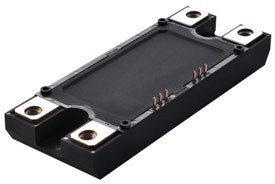Rohm Co Ltd of Kyoto, Japan has started mass-production of the BSM180D12P2C101 1200V/180A-rated silicon carbide (SiC) metal–oxide–semiconductor (MOS) module for inverters/converters used in industrial equipment, photovoltaic power conditioners etc.

The new module is reckoned to be the first to incorporate a power semiconductor consisting of just an SiC metal–oxide–semiconductor field-effect transistor (MOSFET) – without a Schottky barrier diode (SBD) – increasing the rated current to 180A for broader applicability while contributing to lower power consumption and greater compactness. Next-generation SiC MOSFET technology is used to minimize conduction degradation of the body diode, eliminating the need for diode rectification, says Rohm. This makes it possible to increase the mounting area for higher current-handling capability while maintaining the same compact form factor.
In addition, by improving processes and device structures related to crystal defects, Rohm says that it was able to overcome all problems related to reliability, including that of the body diode. With no tail current, the result is 50% less loss compared with conventional silicon insulated-gate bipolar transistors (Si IGBTs) used in general-purpose inverters. This, along with an operating frequency greater than 50kHz, ensures compatibility with smaller, lighter peripheral components for greater end-product miniaturization, says Rohm.
Features of the new module also include:
Reverse conduction possible for high efficiency synchronous rectification – General-purpose Si IGBT devices are not capable of conduction in the reverse direction. In contrast, the body diode in Rohm’s SiC MOSFET always conducts in reverse. Also, depending on the gate signal input, the MOSFET can operate in either direction for lower ON resistance compared with using just the diode. These reverse direction conduction characteristics allow high-efficiency synchronous rectification in the 1000V range – higher than diode rectification. Body diode conduction degradation eliminated, enabling conduction over 1000 hours with no performance loss – Clarifying the mechanism by which defects are spread based on body diode conduction makes it possible to minimize the primary factors through process and device construction. With general-purpose products, the ON resistance increases significantly after 20 hours. In contrast, Rohm’s new module ensures no ON resistance increases, even after more than 1000 hours.





